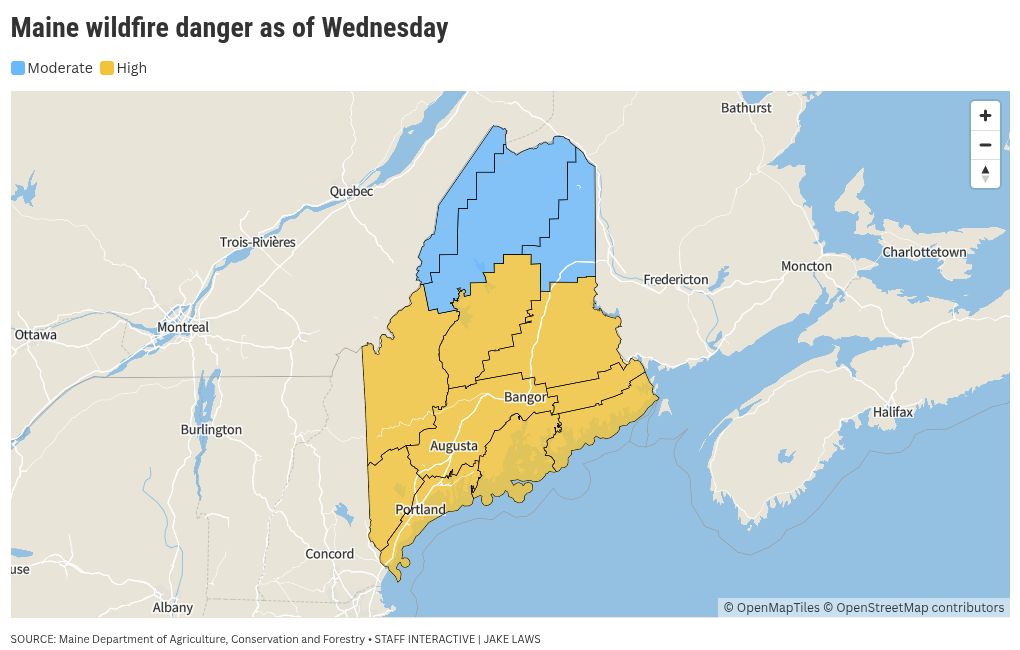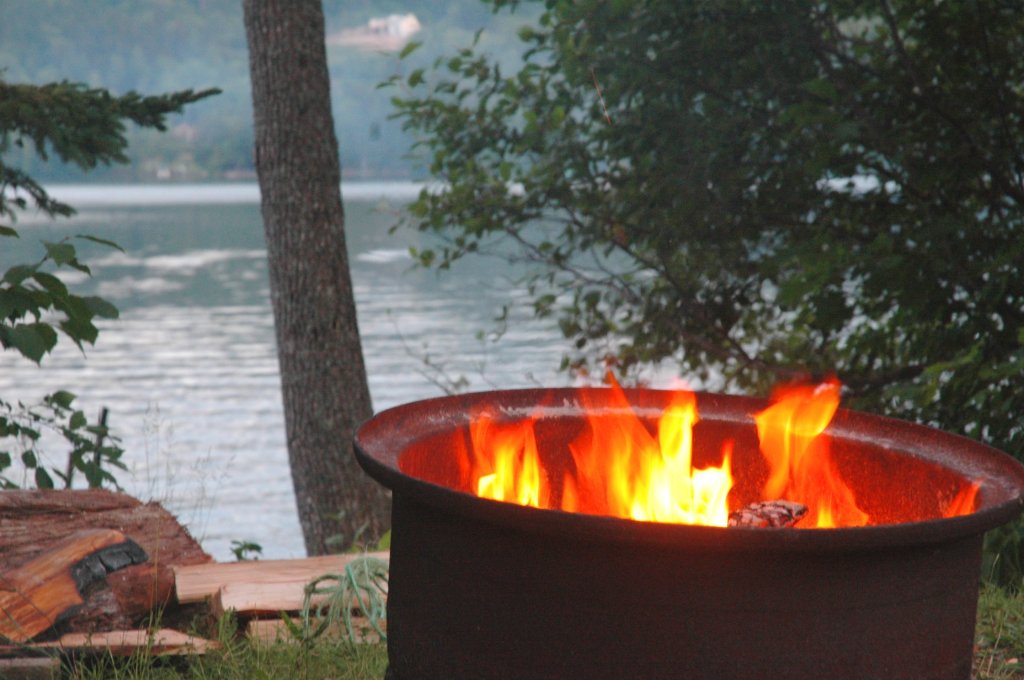
Biddeford firefighter Ryan Jubb drags a hose through the woods while battling a fire Aug. 13. Maine authorities are warning of continued high fire danger amid a weekslong drought. (Shawn Patrick Ouellette/Staff Photographer)
Maine authorities have restricted outdoor burning permits during much of August as the state grapples with a mix of summer heat, a weekslong drought and high wildfire danger.
But what does that mean for Mainers? Can you legally use your fire pit or grill? Are burn permits being issued? And what can you do to prevent wildfires?
Terri Teller, a ranger and fire prevention specialist with the Maine Forest Service, helped answer some questions about burning in Maine, including what you need a burn permit for, how burn permit availability is decided and what can happen if you violate Maine’s burning laws.
Q: What kinds of fires require permits?
A: Debris burning and large campfires.
By state law, open debris burning requires a permit.
“That’s any kind of fire meant to dispose of yard debris or other materials,” Teller said.
Recreational campfires that exceed 3 feet in diameter or 3 feet in height also require a permit. Campfires smaller than that — most backyard firepits — do not require a permit and are still allowed.
Recreational campfires that exceed 3 feet in diameter or 3 feet in height require a burn permit in Maine. Permits have recently been restricted in many parts of the state because of the ongoing drought. (Travis Barrett/Staff Writer)
Q: Can I use my grill?
A: Yes.
Outdoor grills and fireplaces can be used for food preparation without a permit, unless prohibited by a local ordinance. That also includes grills and fireplaces at commercial campgrounds, so long as the campground is licensed by the Department of Health and Human Services.
Q: Are burn permits being issued in Maine right now?
A: It depends on the day and where you live.
Burning permits are not allowed in an area if the wildfire danger is considered high, very high or extreme.
If the risk to an area is considered moderate or below, the state’s online burn permit system will be up and running in that area.
“The last few days, up north, it was lower because they got more rain than others did,” Teller said Monday. “So, the burn permit system is on in those areas.”
From there, municipalities have the final say as to when permits can be issued in their town or city. Officials consider weather conditions, the size of a fire and whether the applicant has sufficient resources to contain the fire.

“We support (local authorities) in making the decisions that make sense for them,” Teller said. “Some towns are instituting more strict requirements.”
The fire danger levels are updated every day at 9 a.m. by the Forest Service and can be seen at mainefireweather.org.
Q: How are wildfire danger levels determined?
A: Analyzing lots and lots of data.
The Maine Forest Service, along with the U.S. Forest Service, National Park Service, and U.S. Fish and Wildlife Service, maintains a network of 17 fire weather stations across the state.
The stations collect data such as temperature, relative humidity and wind speed across 12 zones. That, coupled with data on forest vegetation — “known as ‘fuels’ to fire managers,” Teller said — is how authorities determine the danger level each day. Danger levels are broken into six categories: extreme, very high, high, moderate, low and snow cover.
“Fire danger outputs help inform the public and provide guidance to forest rangers and local fire departments on expected wildfire conditions,” Teller said.
Q: What happens if I’m caught burning without a permit?
A: A court summons and fines.
Burning without a permit is a Class E crime, Teller said, and could lead to a court summons and potentially a fine.
The fine varies depending on the county district court’s decision, Teller said, but can be hundreds of dollars.
A perpetrator could wind up paying even more if an illegal fire spreads.
“If the open burning violation results in an escaped fire, the fire department that responds can also request you pay the cost of suppression,” Teller said.
According to the statute, a perpetrator could be ordered by a judge to pay a maximum of $25,000 to cover a municipality’s suppression costs, or up to $125,000 if the state also incurs costs.
Q: Do humans cause the majority of wildfires in Maine?
A: Yes, the vast majority.
About 90% of wildfires in Maine are caused by humans, according to the Maine Forest Service.
Burning debris is the leading cause, Teller said, but escaped campfires and equipment malfunctions also make up a big portion.
Inappropriate disposal of cigarettes is another common cause.
The remaining 10% of Maine wildfires are caused by natural occurrences, such as lightning strikes.
Q: What’s driving the high wildfire danger levels in Maine?
A: The ongoing drought.
The main driver behind the high levels of wildfire danger across Maine in August has been the ongoing drought, Teller said.

Reynard Gilbert, of Turner, returns from his garden earlier this month with a few string beans, cucumbers and a tomato. “This drought is awful,” he said. “Everything is burnt right up. But if the good Lord wants you to eat out of your garden, he’ll water it. If he don’t want you to, he’ll let it choke to death.” (Russ Dillingham/Staff Photographer)
Whatever else Mother Nature decides to throw toward our corner of the nation has an impact, too.
“The days that we have increased winds and lower relative humidity add to that,” Teller said.
Q: What can I do to prevent wildfires?
A: Heed no-burning advisories and take other precautions.
If there’s a call for no burning in your area, it’s important to adhere to that advisory.
Even if you do get permission to burn, there are other precautions the forest service recommends taking, especially during such a dry season.
Those with fires should keep extinguishers, buckets of water, shovels and hoses handy.
When complete, fires should be drowned with water and checked to ensure there are no embers or coals alight beneath it by stirring with a tool, such as a shovel. People are also asked to use the back of their hand to feel for any heat. If there is heat radiating from the coals, add more water, stir and repeat until they have cooled.
Property owners may also consider dousing flammable parts of their property with water prior to burning. That could include hosing down landscaping and vegetation near structures on the property, such as homes, barns or tool sheds.
“We continue to encourage caution among the public,” Teller said. “It’s important people pay attention to the conditions.”
Copy the Story Link

